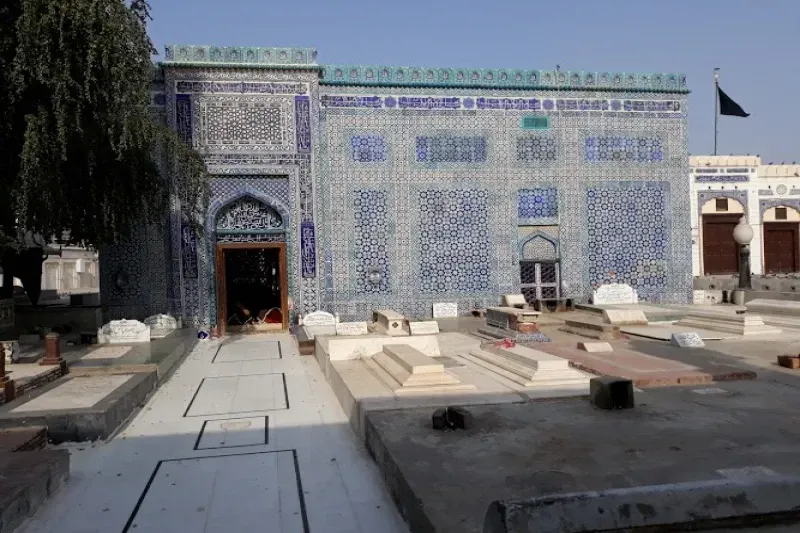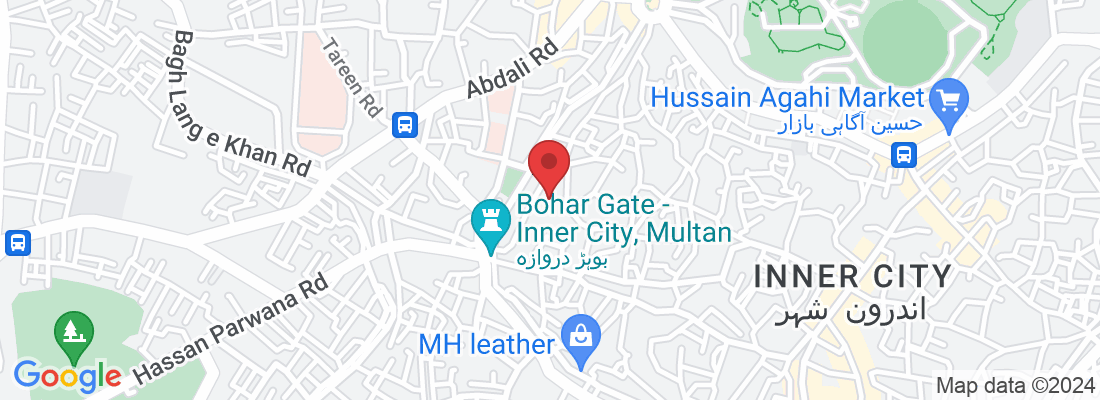MULTAN
City Of Saints
City Of Saints
Mausoleum of Shah Gardez

Shah Yousuf Gardez, commonly known as Shah Gardez, is a revered Sufi saint whose legacy is deeply embedded in the history and culture of Multan, Pakistan. His contributions to the spiritual and social fabric of the region have left an indelible mark, making him a significant figure in the Islamic history of South Asia.
Early Life and Arrival in Multan:
Shah Yousuf Gardez hailed from Gardez, a town in present-day Paktia Province, Afghanistan. He arrived in Multan in 1088 AD, during a period when the city was in a state of decline.His arrival marked the beginning of a new era for Multan, as he played a pivotal role in revitalizing the city and spreading Islam in the region.
Contributions to Multan:
Upon his arrival, Shah Gardez embarked on a mission to restore Multan, which was then suffering from social and economic stagnation. He is credited with converting many locals to Islam, thereby strengthening the Islamic community in the area.His efforts in spreading Twelver Shia Islam were particularly notable, as he established a strong religious foundation that continues to influence the region to this day.
Miracles and Spiritual Influence:
Shah Gardez is also renowned for the numerous miracles attributed to him. These miracles, along with his piety and dedication, earned him a revered status among the people of Multan.His spiritual influence extended beyond the city, attracting followers from various parts of the region who sought his guidance and blessings.
Someone says about Shah Gardez:
ملتانی سرزمین کا عظیم ولی
حضرت شاہ گَردیز کی روشنی جلی
صوفیٔ پاک، دلوں کے امام
آپ کے قدموں میں ہے دلوں کا سکونِ تمام۔
Architectural Legacy:
One of the most enduring legacies of Shah Gardez is his tomb, located just inside the Bohar Gate in Multan. The tomb is a rectangular, domeless structure adorned with intricate glazed tiles, a hallmark of Multani architectural style.The interior of the shrine is decorated with extensive mirror-work known as āina-kāri, adding to its aesthetic and spiritual appeal.The tomb of Shah Gardez is not just a place of burial but a symbol of his lasting impact on the city. It serves as a site of pilgrimage for devotees who come to pay their respects and seek spiritual solace.The shrine’s architecture reflects the rich cultural heritage of Multan, blending Islamic art with local craftsmanship.
Cultural Significance:
Shah Gardez’s influence extends beyond the religious sphere, permeating the cultural fabric of Multan. His teachings and legacy have been preserved through oral traditions, poetry, and local folklore.The annual Urs (death anniversary) of Shah Gardez is a significant event in Multan, drawing thousands of devotees who participate in various religious and cultural activities to honor his memory.
Impact on Sufism:
As a Sufi saint, Shah Gardez’s contributions to the development of Sufism in South Asia are profound. His emphasis on spiritual purity, devotion, and service to humanity resonated with many, leading to the establishment of a strong Sufi tradition in Multan.
His teachings continue to inspire Sufi practitioners and scholars, contributing to the rich tapestry of Islamic mysticism in the region.
Short Words:
Shah Yousuf Gardez’s legacy is a testament to his enduring impact on the city of Multan and its people. His efforts in revitalizing the city, spreading Islam, and performing miracles have cemented his place as a revered figure in the annals of South Asian history. The architectural beauty of his tomb and the cultural traditions that celebrate his life are enduring reminders of his contributions. Shah Gardez’s life and legacy continue to inspire and guide generations, making him a timeless symbol of spiritual devotion and cultural heritage.
What is the Tomb of Shah Gardez?
The Tomb of Shah Gardez is a significant historical mausoleum located in Multan, Pakistan. It is the resting place of Shah Yousaf Gardezi, a revered Islamic missionary and Sufi saint from the 12th century.
Where is the Tomb of Shah Gardez situated?
The tomb is located in the walled area of the ancient city of Multan, Punjab, Pakistan.
Why is the Tomb of Shah Gardez significant for tourists?
The tomb is an important site due to its historical value, unique architecture, and cultural importance. Visitors can experience the serene atmosphere of a Sufi shrine, observe traditional Islamic art, and gain insights into the region’s spiritual heritage.
What can tourists expect to see at the Tomb of Shah Gardez?
Tourists can see intricate tile work, splendid calligraphy, and a blend of Islamic and sub-continental design elements. The complex also includes a mosque and offers a peaceful environment for reflection.
Are there any cultural norms or dress codes to be aware of when visiting?
Yes, visitors are expected to dress modestly and respect the sanctity of the shrine. It is advisable to cover your head and wear conservative clothing.
Are there any annual events or festivals at the Tomb of Shah Gardez?
The shrine hosts various religious events and festivals that attract devotees and tourists alike.
Is photography allowed inside the Tomb of Shah Gardez?
Photography policies may vary, so it is best to check with local authorities or guides at the site.
Are guides or tours available for learning more about the Tomb of Shah Gardez?
Yes, guides and tours are often available to provide more detailed information about the history and significance of the tomb.
What is the best time of the year to visit the Tomb of Shah Gardez?
The best time to visit is during the cooler months, from October to March, to avoid the extreme heat of the summer.
How can one reach the Tomb of Shah Gardez?
The tomb is accessible by road and is located within the city of Multan. Local transportation options include taxis, rickshaws, and buses.
What is the Tomb of Shah Gardez?
The Tomb of Shah Gardez is a significant historical mausoleum located in Multan, Pakistan. It is the resting place of Shah Yousaf Gardezi, a revered Islamic missionary and Sufi saint from the 12th century.
Where is the Tomb of Shah Gardez situated?
The tomb is located in the walled area of the ancient city of Multan, Punjab, Pakistan.
Why is the Tomb of Shah Gardez significant for tourists?
The tomb is an important site due to its historical value, unique architecture, and cultural importance. Visitors can experience the serene atmosphere of a Sufi shrine, observe traditional Islamic art, and gain insights into the region’s spiritual heritage.
What can tourists expect to see at the Tomb of Shah Gardez?
Tourists can see intricate tile work, splendid calligraphy, and a blend of Islamic and sub-continental design elements. The complex also includes a mosque and offers a peaceful environment for reflection.
Are there any cultural norms or dress codes to be aware of when visiting?
Yes, visitors are expected to dress modestly and respect the sanctity of the shrine. It is advisable to cover your head and wear conservative clothing.
Are there any annual events or festivals at the Tomb of Shah Gardez?
The shrine hosts various religious events and festivals that attract devotees and tourists alike.
Is photography allowed inside the Tomb of Shah Gardez?
Photography policies may vary, so it is best to check with local authorities or guides at the site.
Are guides or tours available for learning more about the Tomb of Shah Gardez?
Yes, guides and tours are often available to provide more detailed information about the history and significance of the tomb.
What is the best time of the year to visit the Tomb of Shah Gardez?
The best time to visit is during the cooler months, from October to March, to avoid the extreme heat of the summer.
How can one reach the Tomb of Shah Gardez?
The tomb is accessible by road and is located within the city of Multan. Local transportation options include taxis, rickshaws, and buses.
We use cookies to ensure that we give you the best experience on our website.
© Copyright Multan 2024


Facebook
LinkedIn